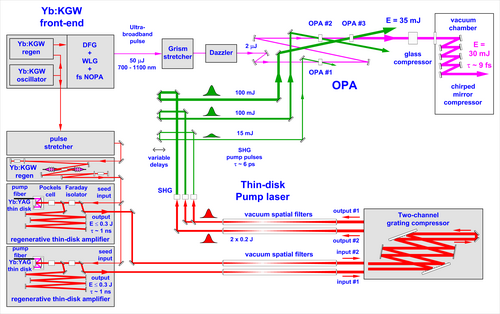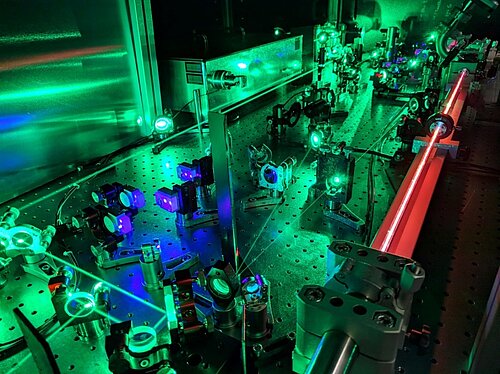4.1 Implementation of Lasers and Measuring Techniques
Project coordinators: I. Will , F. Furch , M. van Moerbeck-BockT2: OPCPA engineering
In the frame of this topic advanced OPCPA sources generating ultrashort pulses in the near- and mid-infrared wavelength range have been developed. The high energy OPCPA systems have been nearly completed in 2018 and provide record-setting output parameters. The application of these OPCPA sources dedicated for the research in the Program Areas 2 and 3 require significant attention to reliability and stability of the systems. This implies that the improvement and engineering of these OPCPA systems is an important and constant theme in this topic.
Terawatt OPCPA system
Ingo Will, Tamas Nagy, Johannes Tümmler, Martin Kretschmar
The TW-class few-cycle OPCPA system is intended for attosecond-pump attosecond-probe experiments. By means of high harmonic generation (HHG) an isolated attosecond pulse (IAP) will be produced. Therefore, an intensity I > 1013 W/cm2 over a large focal volume with CEP-stable few-cycle near-IR pulses is required. To achieve this requirement pulses with E >> 10 mJ energy and a duration below 10 fs are needed.
The TW OPCPA system consists of three OPCPA stages that are pumped by a thin-disk laser system. A common Yb:KGW oscillator generating pulses in the spectral range of 1030 nm is used for generating the pump pulses as well as for creating the broad band seed pulses to be amplified in the OPCPA stages. The system is operating at 100 Hz.
For the pump laser the oscillator output is stretched with a grating stretcher and pre-amplified in an Yb:GKW regenerative amplifier. With this pulse two Yb:YAG regenerative thin-disk amplifiers are seeded. Theses amplifiers increase the pulse energy to a level of more than 200 mJ, each. In a grating compressor the pulses are compressed to below 10 ps pulse duration and converted in LBO crystals to 515 nm green light. In total 3 pump pulses with pulse energy of up to 100 mJ are avialable. The thin-disk amplifiers were developed during the last few years within project 1.2. Here you will find further information on this work and the principle of thin-disk amplifiers.
For the seed pulse the output of the common oscillator is used in a commercial system (fs-NOPA) to generate broadband pulses from 700 nm to 1100 nm wavelength supporting a pulse duration of 7 fs. These pulses are negatively chirped in a GRISM stretcher. After a DAZZLER, used for phase corrections, only 2µJ pulse energy in a 5 ps long chirped pulse are left. This beam is used as seed in the following three OPCPA stages.
The three OPCPA stages are based on BBO crystals with a thickness between 1.5 mm and 3 mm and an aperture of up to 20 mm x 20 mm. In these three stages the pulse energy is increased to a level of more than 30 mJ. Due to the negative chirp this pulse can be compressed with low losses in a thick SF6 glass block. A set of dielectric-chirped mirrors is used for the final compression to below 10 fs pulse duration. The image below shows a FROG measurement of the pulse duration.
Near-IR high repetition rate OPCPA
Mikhail Osolodkov, Tobias Witting, Federico Furch
Ultrashort laser pulses have enabled a myriad of applications over the years. In this activity we focus on developing sources delivering laser pulses with durations down to a few optical cycles, at high average power and high repetition rate based on optical parametric chirped pulse amplification (OPCPA) and nonlinear compression techniques. These sources are tailored for two particular applications: Attosecond pump-probe spectroscopy with coincidence detection of ions and electrons (project 2.1), and for novel approaches for direct laser micro-processing of optical glasses (project 3.2). In both cases, the combination of high repetition rate (>> 10 kHz), moderate to high energy per pulse (10 µJ - 200 µJ) and short pulse duration (few optical cycles) are essential components for the intended applications. Carrier-envelope phase control is also of fundamental importance for some of the targeted applications.
Our approach is to amplify ultrashort pulses from an octave-spanning CEP-stable Ti:Sapphire oscillator at 800 nm, in a noncollinear OPCPA. A small portion of the spectrum of the oscillator, centered at 1030 nm is filtered out and coupled into an optical fiber. The rest of the spectrum represents the seed for the parametric amplifier. The pulses at 1030 nm seed a fiber chirped pulse amplifier (CPA), or alternatively an Yb:YAG thin-disk based CPA. The frequency doubled output of the CPA (515 nm) is the pump light for the parametric amplifier. The pulses are amplified in BBO crystals under type I phase matching. For pulse compression we employ a combination of chirped mirrors and a liquid crystal spatial light modulator based pulse shaper, located before the amplifier. In addition, we implement nonlinear pulse compression techniques in order to reach the single-cycle limit in pulse duration.
Systems under operation:
- Fiber-CPA-pumped OPCPA at 800 nm delivering CEP-stable, 7 fs pulses with 10 μJ of energy at 400 kHz.
- OPCPA at 800 nm pumped by a CPA based on a thin-disk regenerative amplifier, delivering CEP-stable, 7 fs pulses with 190 μJ of energy at 100 kHz.
- Nonlinear compression of the OPCPA: < 4 fs pulses, 90 μJ at 100 kHz.
Midwave-IR OPCPA driver for x-ray generation
Lorenz v. Grafenstein, Uwe Griebner
A midwave-IR (MWIR) OPCPA system operating at 1 kHz has been developed. This system is now at an advanced stage and used as driver laser for the Cu Ka source utilized in MBI’s time-resolved X-ray diffraction research (see project 3.3).
The setup of our MWIR OPCPA system is shown in Fig. 3. Access to the wavelength range above 4 µm at reasonably high conversion efficiency depends critically on powerful 2-µm pump sources to exploit the high nonlinearity of ZnGeP2 (ZGP) crystals for parametric amplification. We made significant progress in the development of highly-stable 2-µm picosecond pump lasers based on Ho:YLF chirped pulse amplifiers reaching more than 10 GW peak power. The OPA consists of three stages using ZGP. In the 1 kHz pulse train of the OPCPA, up to 3.5 mJ idler pulses are generated. A ~800 nm bandwidth (FWHM) of the idler, centered at 5.0 µm, is achieved, supporting a Fourier-transform limited pulse duration of ~50 fs. CaF2 crystals are implemented for compression of the positively chirped idler pulses. Compensating the residual GDD, TOD and FOD of the pulses by a spatial light modulator, successful recompression is achieved. The resulting pulse duration of 80 fs corresponds to a sub-five-cycle signature. This pulse characteristic translates into a peak power of several ten GW, which represents a new peak performance level at wavelengths longer than 4 µm.


